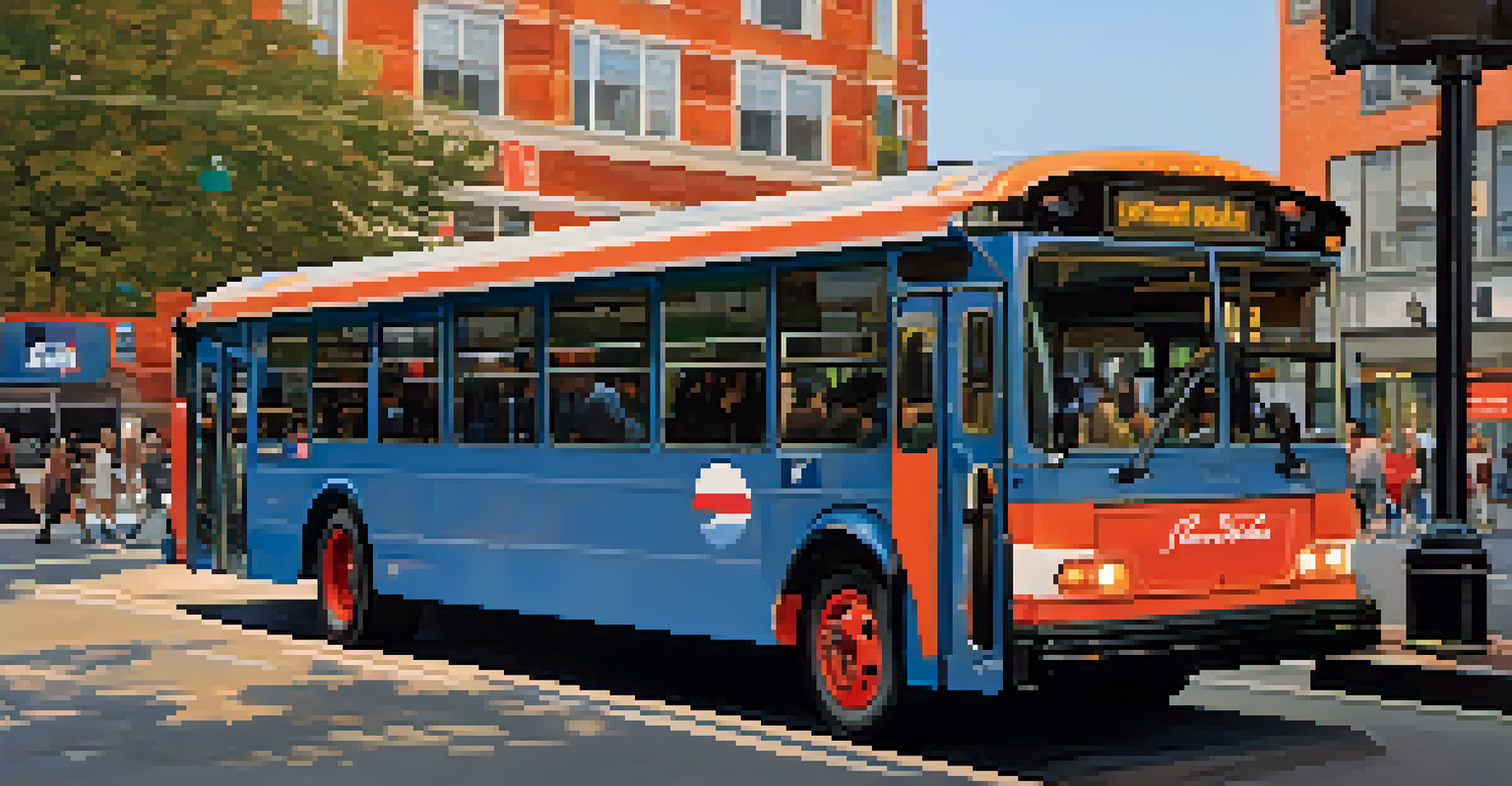Impact of Public Transportation on Urban Mobility in Philly

Understanding Urban Mobility and Its Importance
Urban mobility refers to how people move within a city, encompassing various modes of transportation including walking, biking, and public transit. It's crucial because it influences everything from daily commutes to economic growth. A well-functioning urban mobility system can reduce congestion, improve air quality, and enhance access to essential services.
Public transportation is a vital part of the solution to reducing traffic congestion and promoting sustainable urban development.
In a bustling city like Philadelphia, effective urban mobility means more than just getting from point A to point B; it connects communities and fosters social equity. People who rely on public transportation often face unique challenges, making it essential to consider their needs in mobility planning. Understanding this context is key to evaluating the impact of public transportation in Philly.
Moreover, urban mobility affects the overall quality of life for residents. When people have access to reliable and affordable transportation options, they can better engage with their neighborhoods and local economies. This interconnection highlights the importance of public transportation as a vital component of urban mobility.
Public Transportation Systems in Philadelphia
Philadelphia boasts a diverse public transportation system, including buses, subways, and regional rail operated primarily by the Southeastern Pennsylvania Transportation Authority (SEPTA). This extensive network plays a crucial role in facilitating daily commutes for thousands of residents. Understanding how these systems function can help us appreciate their impact on urban mobility.

SEPTA's services are designed to cover a wide geographic area, making it possible for people to traverse the city and its suburbs efficiently. However, like many urban transit systems, it faces challenges such as aging infrastructure and funding constraints. Addressing these issues is essential for maintaining and enhancing the effectiveness of public transportation in Philadelphia.
Key Role of Public Transit
Public transportation is essential for enhancing urban mobility, connecting communities, and promoting economic growth.
Additionally, the diversity of transportation options allows for flexibility, catering to different commuter needs. From the bustling Market-Frankford Line to the quieter trolley services, each mode plays a role in shaping urban mobility. This variety underscores the importance of public transportation in creating a dynamic and accessible city.
The Role of Public Transportation in Reducing Traffic Congestion
One of the significant impacts of public transportation is its ability to reduce traffic congestion. In a city like Philadelphia, where the streets can become overcrowded, an efficient public transit system can alleviate pressure on roadways. By providing an alternative to single-occupancy vehicles, public transportation encourages more sustainable commuting practices.
Accessible public transportation is essential for creating inclusive cities where everyone can participate in the economy and society.
Studies have shown that increased public transit usage can lead to a noticeable decrease in traffic congestion. For instance, as more people opt for buses or trains, the number of cars on the road diminishes, resulting in smoother traffic flow. This not only benefits commuters but also contributes to lower emissions and a healthier urban environment.
Moreover, reducing congestion can have a ripple effect on the economy. Less time spent in traffic means more time for work and leisure, enhancing overall productivity. This interconnectedness illustrates how vital public transportation is in promoting not just mobility but also economic vitality.
Public Transportation and Environmental Sustainability
Public transportation plays a vital role in promoting environmental sustainability, particularly in urban areas like Philadelphia. By encouraging the use of buses and trains, cities can significantly reduce greenhouse gas emissions compared to individual car travel. This shift not only benefits the environment but also improves public health by reducing air pollution.
Moreover, public transit systems are generally more energy-efficient than private vehicles. For example, a single bus can replace dozens of cars on the road, leading to a considerable reduction in carbon footprints. This efficiency is crucial for cities aiming to meet climate goals and create cleaner, healthier living spaces.
Environmental Benefits of Transit
Using public transport significantly reduces greenhouse gas emissions and supports sustainable urban development.
In addition to lowering emissions, public transportation can also support sustainable urban development. By concentrating transit options in specific areas, cities can promote walkable neighborhoods and reduce urban sprawl. This holistic approach to urban planning further underscores the environmental benefits of investing in public transit.
Enhancing Accessibility Through Public Transportation
Accessibility is a critical aspect of urban mobility, and public transportation can significantly enhance it for various populations. In Philadelphia, accessible transit options are essential for individuals with disabilities, seniors, and low-income residents who may not own a vehicle. By providing reliable transit services, cities can create inclusive spaces for all residents.
Efforts to improve accessibility, such as installing ramps, elevators, and specialized services, make public transit more usable for everyone. These enhancements allow individuals who might otherwise be isolated to engage more fully with their communities. This inclusivity is key to fostering social equity in urban environments.
Moreover, when public transportation is accessible, it can open up job opportunities and essential services for underserved populations. This not only enriches individual lives but also strengthens the community as a whole. Accessible public transit is thus a cornerstone of effective urban mobility.
Challenges Facing Public Transportation in Philadelphia
Despite its benefits, public transportation in Philadelphia faces a range of challenges that can hinder its effectiveness. Funding issues are a primary concern, with budget constraints often limiting service improvements and maintenance. These financial hurdles can lead to service cuts, affecting the overall reliability of transit options.
Additionally, aging infrastructure poses significant challenges for SEPTA and its riders. Many of the systems in place are in desperate need of upgrades, which can result in delays and diminished user experiences. Addressing these infrastructure concerns is crucial for ensuring that public transportation remains a viable option for commuters.
Challenges in Philly's Transit System
Funding issues and aging infrastructure pose significant challenges to the effectiveness and reliability of public transportation in Philadelphia.
Furthermore, public perception and ridership levels also play a role in the effectiveness of these systems. If residents view public transportation as unreliable or inconvenient, they may be less inclined to use it. Building confidence in public transit is essential for increasing ridership and maximizing its positive impact on urban mobility.
Future Directions for Public Transportation in Philly
As cities evolve, so too must their public transportation systems. In Philadelphia, there are exciting opportunities for innovation and improvement in transit services. Embracing new technologies, such as real-time tracking apps and electric buses, can enhance the user experience and make public transit more appealing.
Moreover, integrating public transportation with other forms of mobility, such as bike-sharing programs and ride-hailing services, can create a seamless commuting experience. This holistic approach encourages residents to consider public transit as a convenient and efficient option for getting around the city. By fostering these connections, Philadelphia can improve urban mobility for everyone.

Lastly, community engagement is vital in shaping the future of public transportation. Involving residents in the planning process ensures that the services meet the needs of the community. As Philadelphia looks ahead, prioritizing public transportation can lead to a more connected, sustainable, and accessible urban environment.